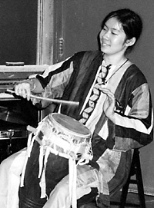A violinist, music theorist, Senegalese percussionist and ethnomusicologist, Patricia Tang brought her diverse musical background to MIT last fall when she joined the music and theater arts section as assistant professor. Tang, who graduated from Brown University with a degree in music and received a Ph.D. in ethnomusicology from Harvard in 2001, teaches "Introduction to World Music," "Music of Africa" and sections of "Introduction to Western Music."
She also is the founder and leader of Rambax MIT, an ensemble dedicated to the Senegalese art of sabar drumming. On Saturday, Dec. 7, the 12-member group will give its debut performance with Senegalese master drummer Lamine Toure, who has worked with the group this fall as artist-in-residence.
Christina Jensen of the Office of the Arts interviewed Tang about her work with Rambax MIT .
Q: What does Rambax MIT add to the campus music scene?
A: I think it's important to have a number of world music ensembles on any campus; it adds a necessary diversity to the music scene. Performance ensembles are often the best way to get students interested in world music, and as an ethnomusicologist, I feel the need to not only teach students through lectures and readings, but by hands-on experience in making music. Rambax is just part of my overall teaching philosophy regarding the importance of music-making.
Q: Tell me about Lamine Toure. What is his rehearsal style?
A: Lamine is a dedicated, effective and fun teacher. Although his English is limited, it does not impact his teaching at all, as he is able to convey so much through example. The students learn the bakks [musical phrases] through imitation since there is no written tradition in sabar drumming. Lamine breaks down the patterns and teaches by having the students imitate his movements and recite the phrases through the use of vocal mnemonics. Many of the phrases stem from spoken word, and he has the entire group speaking Wolof, his native language. It's really quite amazing.
Although the drum patterns we're learning are at times very challenging, Lamine is always extremely encouraging. He also injects a good dose of humor into our rehearsals; we always have a lot of fun during practice. I hope we can continue to work with him in the future.
Q: What do you hope the audience takes away from Rambax's performance?
A: I hope they gain a better understanding and appreciation for Senegalese sabar drumming. But most of all, they should just have fun! Sabar drumming in Senegal is played for a variety of occasions, from weddings to baptisms, but the general purpose is to make music for people to dance to and have fun. We hope the Rambax performance will serve a similar purpose. It promises to be a fun and exciting show, and the audience will be invited to dance, too.
Rambax MIT meets on Tuesdays from 7:30 to 9:30 p.m. in Room N52-199 (the Endicott World Music Room). The ensemble will perform at 8 p.m. on Saturday, Dec. 7 in La Sala de Puerto Rico in the Stratton Student Center. For more information, e-mail Tang at pjtang@mit.edu.
A version of this article appeared in MIT Tech Talk on November 20, 2002.






